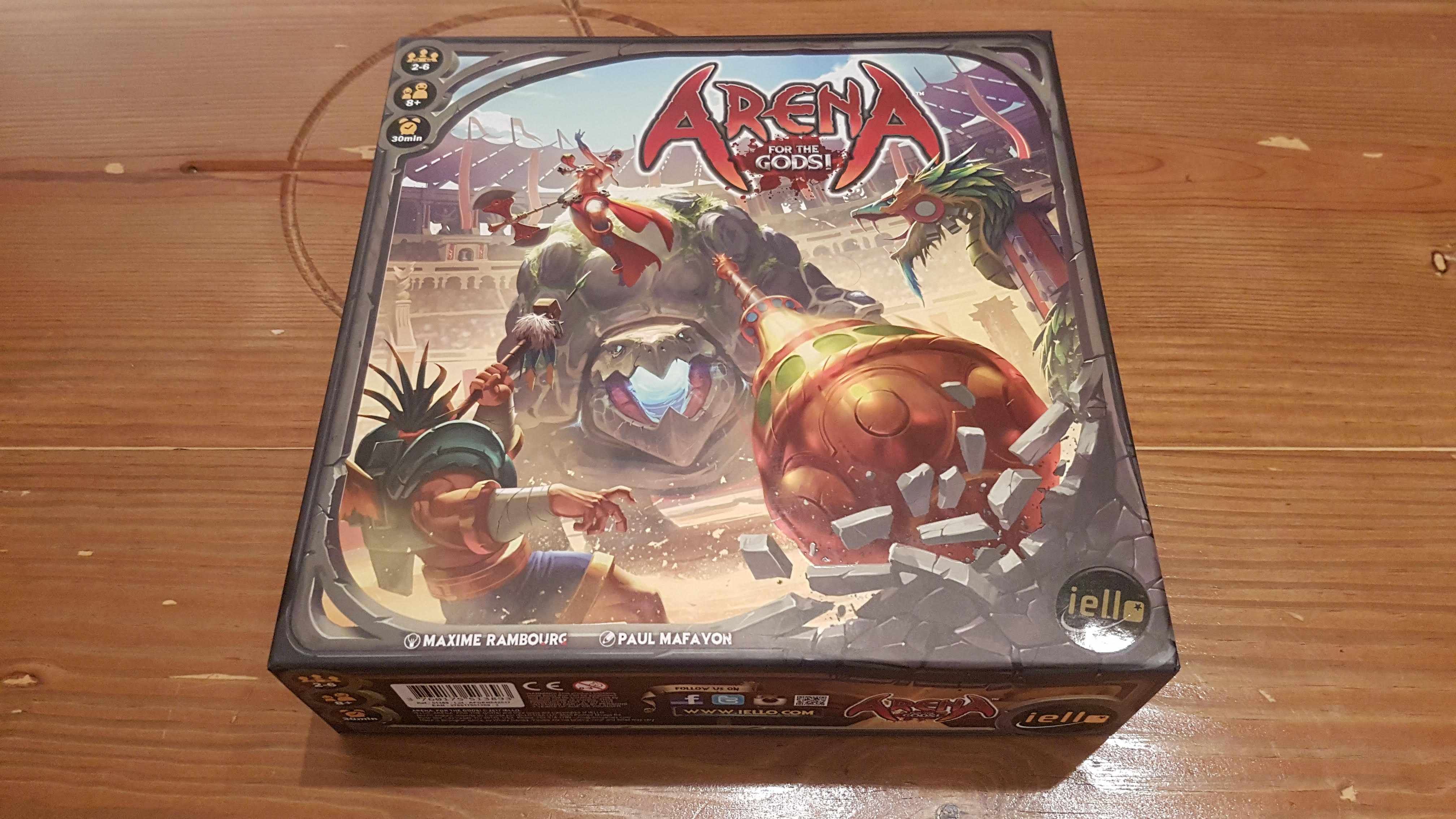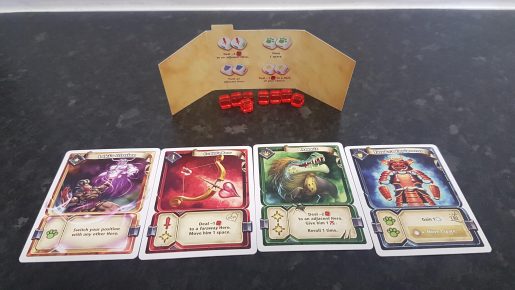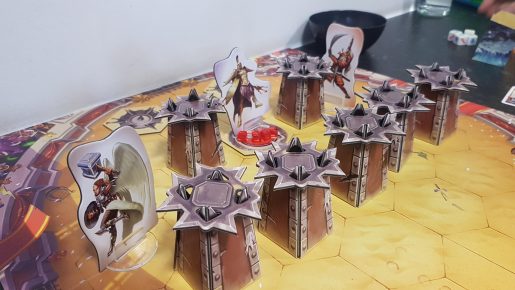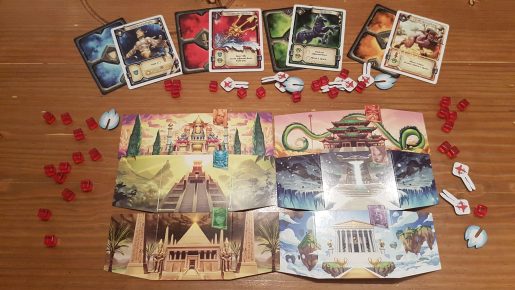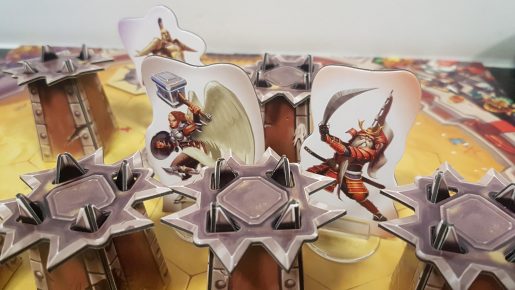Arena For The Gods! is a dice rolling, combat focused board game from designer Maxime Rambourg and publisher IELLO. Released last year, the game sees 2 – 6 players taking up the role of combatants fighting it out in, unsurprisingly, an arena. With plenty of mythological equipment, such as Mjölnir, and mounts, such as a Pegasus, there is plenty take into battle. However, is this Yahtzee style dice roller a King of Tokyo killer? Let’s find out!
For setup, players choose a character and take 20 life points from the communal pool, hiding them behind a player screen. The game of Arena: For the Gods! is played out over two phases. Firstly, players will be bidding for equipment, mount, spell and weapon cards with from their life points pools. So, the player who bids the most gets first pick but will have spent more health, thus balancing stronger powers via lower health pools.
Once this phase is over it is time to fight in the arena. Each player gets to place their character’s standee onto an edge space of the arena and then the dice chucking commences. On a turn, players will roll 7 dice, minus 1 dice per exhaustion token, with 1 re-roll available. These dice feature four symbols: swords, spells, movement and shields. Each player can perform as many actions as they can afford with the dice and have access to basic actions and player specific actions.
The basic actions are move 1 space (costing 2 movement symbols), deal 1 damage to an adjacent character (costing 2 sword symbols), deal 1 damage to a hero in line of sight (costing 2 spell symbols) and push an enemy character back one space (costing 2 shield symbols). Having these basic actions means you can almost always do at least some actions. Nevertheless, player specific actions, which come from the cards purchased in the initial bidding phase, are often more powerful. These can range from dealing greater damage, dealing out exhaustion or even switching position with any other hero.
Pushing might sound a slightly lacklustre action to take, however push an opponent into a trap or the wall and they will take damage. There is a second floor component, opposite to traps, in the form of health pools. Each time a character moves onto a health pool they get to claim one of their starting 5 health cubes, which can be vital for staying in the game. These pools run out fast, especially as the player count increases, making them hotly contested early on.
As soon as a turn ends where a player’s health pool has been reduced to zero the game ends. At this point the winner is crowned as the combatant with the most life cubes remaining. This circumvents and issues of player elimination and also stops players consistently ganging up on one player. Players need to make sure all other characters are taking damage not just one consistently, thus the game can turn into a dance around the arena not just an aggressive brawl.
Depending on two factors, desired game length and player count, the game board can be setup differently. While it is more to keep the balance when it comes to player counts, to make sure that movement or close quarter adjacency aren’t more powerful, it is the ability to reduce or increase the length of the game that impresses me. It doesn’t matter if you want to fit in a quick game, or spend a bit longer dancing around each other, you can adjust the board to make the game a more desired length.
While the bidding phase for weapons, mounts, equipment and spells is on the slow side, being only at the very start of the game gets it out of the way, for the fun combat to occur and go uninterrupted. There is an Instant Combat variant that the rules suggest and it’s not something you want to skip. Otherwise your first impressions of the game will be tainted by an experience of not really knowing what you are doing or what is most beneficial. A table that assigns equipment out to the heroes, almost surprising this isn’t the basic game with bidding being the variant. It seems odd they would go to the all the effort to come up with default character equipment which I’m sure has been balanced just to throw the bidding mechanisms in.
In a similar way to spending energy for cards in King of Tokyo, for your first game players will have very little understanding of what is an appropriate amount to bet in the initial auction phase. After the game has played out players will either feel they were always in a losing position from bidding way too much or everyone will have bid conservatively and cards will basically be randomed. After a couple of games players will start to know the “right” amounts however as soon as a new player joins the issue returns, with major advantages going to the experience players unless during the teaching exact bidding knowledge is passed on.
While the mechanisms balance out bidding high to get first choice, giving a potentially more powerful card, entering the game with significantly lower health via over bidding is a painful experience. The other briefly mentioned issue is the randomness if two players bid the same. Players should then enter a bartering stage able to offer a health cube in return for first pick. After a suggestion of card drafting we did give it a go and while it seemed to work, entering the arena with full health pools did increase the length of the game.
It is a bit of a shame that the spikey pillars must be dismantled between games. This adds only 30 seconds to set up but there is something nice when opening a box and all the components are either completely pre-built for you or built by yourself last time you played. This will by no means stop the game hitting the table, though components like these with bending cardboard do make me worry if they’ll stay solid and robust over time.
Arena For The Gods! is like a distilled version of King of Tokyo, focused towards just the combat. It utilizes the same dice mechanics but throws out the king of the hill concept, replacing it with positioning. With an eye-catching arena to battle in, the character standees and the way the pillars pop from the board the game will draw attention and helps build the narrative of the game. The tall pillars that block parts of the arena off also make the accessible hexagons very easy to see, making movement decisions quicker, allowing the game to keep flowing at a fast pace. Arena For The Gods doesn’t quite have the same instant mass appeal as King of Tokyo. Yet, for gaming groups that see victory points being a worthless commodity in IELLO’s 2011 title, Arena For The Gods combat will surely win them over!
[Editor’s Note: Arena For The Gods! was provided to us by Coiledspring Games for the review.]

